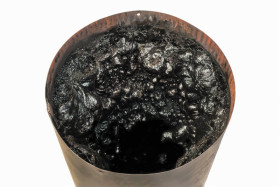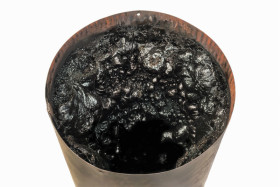What is creosote?
As chimney cleaning professionals, we’re constantly bombarding you with messages about creosote. “Have your chimney cleaned from dangerous creosote.” “Creosote can lead to a dangerous chimney fire.” “Creosote is the biggest hazard to your chimney’s safety.” Too infrequently, however, we don’t explain what creosote is or how creosote can threaten your chimney and your home’s safety. In this blog, we’re going to lay give you the inside scoop on creosote: How it forms, how it endangers your chimney and how you can keep creosote at bay.
What is creosote?
Creosote is a highly flammable byproduct of the fires you burn in your fireplace. You know your fire produces smoke. As that smoke travels up your chimney it cools, and condensation forms on the walls of your chimney. When that condensation hardens, it becomes creosote. Creosote can be sticky and tarlike or smooth and shiny. It can be muddy brown or dark, dark black. In most chimneys, creosote can exist in multiple forms and usually does.
What dangers does creosote pose?
The primary danger creosote poses is the risk of a chimney fire. Creosote is highly flammable. If it reaches a high enough temperature, or if a stray ember from your fire enters the chimney and comes into contact with the creosote, it can ignite and cause a chimney fire, putting your home at risk. Creosote also can block off your chimney’s opening, preventing smoke and carbon dioxide from the fireplace. A blockage can force smoke and carbon dioxide back into your home, posing a danger to your family’s health. Creosote also poses some less sever risks. Like most fire byproducts, creosote is acidic and can cause corrosion or damage to your chimney’s flue. In the warm summer months, creosote also can cause a foul smell to fill your home.
How can you keep the dangers of creosote at bay?
The best way to protect your chimney and your home from the dangers of creosote is with regular chimney sweepings. Your annual chimney sweeping will clear any creosote away from your chimney, dramatically lowering your risk of a chimney fire. Your annual inspection also will screen your chimney for signs of a previous creosote-induced chimney fire. You also can reduce creosote buildup in your chimney by burning a hot, efficient fire. Burn only dried, seasoned firewood that is properly sized for your fireplace. Always fully open fireplace doors so your fire can draw in enough oxygen to keep it burning at its hottest. Make sure your damper is opening fully, as a partially closed damper can cause smoke to linger in your flue, causing creosote to form more rapidly in your chimney.
Call Your Chimney Sweep today to protect your chimney from the dangers of creosote. Our certified chimney sweeps will remove dangerous creosote from your chimney and look for any signs of fire damage in your chimney’s flue. We also can advise you on keeping your chimney creosote free and keeping your family safe from the dangers of a creosote-sparked chimney fire.


